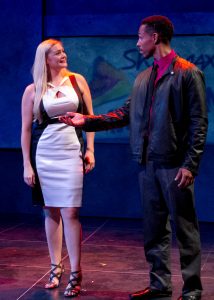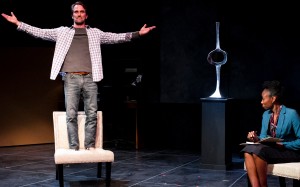‘Honky’ Offers Laughs, Not Solutions
Greg Kalleres’ play, Honky, performing through December 7 at the San Diego REPertory Theatre’s Lyceum Space, is a satire. If you read the play’s title and were relieved by this information about its genre you’ve started to get Mr. Kalleres’ point.
Set in present-day New York, Honky follows a group of characters who have some association with a company that makes Sky Max basketball shoes. Sky Max shoes are designed for and marketed to urban teenagers, most of whom are Black. The company prides itself on the quality of the product and on its unique niche, but its success has made acquiring it potentially attractive to the likes of Nike.
Enter Davis Tallison (James Newcomb), old-school manager and self-described “salesman,” who has been hired by the board to expand the market so that the company will draw a higher price when sold. But, Davis quickly manages to offend several African-American employees, including chief shoe designer Thomas Hodge (Gerard Joseph). Hodge is angry enough by the offense that he decides to take on other white elements of the company, including Peter Trammel (Francis Gercke), who designed an ad campaign for the latest version of the shoe that Thomas finds offensive. The search for Peter leads to two more connections: Andie Chastain (Jacque Wilke), Peter’s fiancé, and Thomas’ sister, Emilia (Tanya Alexander), who, it turns out, is Peter’s therapist.
But, Mr. Kalleres isn’t satisfied solely with exploring these interrelationships. He also throws in what Alfred Hitchcock called a “McGuffin,” a device that isn’t really important in and of itself but which binds the characters together. In this case, the McGuffin is an anti-racism pill, which has been marketed to and is taken by several of the characters. Mr. Kalleres wants this pill to be the “modest proposal” that drives the satire but instead it drags down the plot, affording only hallucinatory meetings between the play’s characters and historic civil rights leaders that serve only to reiterate points made elsewhere.
Satire has to be funny to work, though, and Mr. Kalleres, a former writer of television commercials, has crafted a string of funny lines that begin early on and sustain audience engagement through the 100-minute, no-intermission, running time. Mr. Kalleres has a keen sense of cultural currency, and his digs at media institutions and the commercial masters they serve are both sharp and well-observed.
Ultimately, though, the play doesn’t give voice where it belongs. Scholars have posited that in situations where there are oppressors, oppressed, and outside observers, those who are oppressed tend to have the most accurate picture of the situation and thus deserve a dominant voice in understanding it. Honky has two characters with potential for speaking such truth, called Kid 1 (DeLeon Dallas) and Kid 2 (Cortez L. Johnson). Unfortunately, Mr. Kalleres is more interested in playing with the stereotypes these two characters represent than in the truth-telling they might provide.
Director Sam Woodhouse’s production can’t fix the play, but it can and does show its audience a good time. The casting is about as perfect as one could imagine, and in particular Ms. Wilke’s off-the-wall bimbo is one of the most fully-realized characters this prolific local actress has ever created. And, the actors’ excellent sense of timing deliver the laughs and go easy on the muddle created by the script.
The technical aspects attempt to cover the limitations of performing in the intimate Lyceum Space. The cast efficiently executes the many scene changes required, and Sean Fanning’s scenic design creates a raft of distinctly different spaces (including two different bedrooms) with a few pieces that roll or may be carried into place. Sherrice Mojgani’s lighting design continues to show her as one of the bright young stars working in this craft. Kevin Anthenill’s complex sound design strikes the right balances in creating a “hip” feel for the production, ditto Valerie Henderson’s costume design.
In the end, Mr. Kalleres doesn’t offer much more of a point than that our critique of relations among racial groups has left us inarticulate (and, in fact, one of the characters is rendered inarticulate by the time the play’s end has been reached). The point is well taken, but the ability to be articulate about difficult topics requires negotiation, not just assertions by one group or another. What Mr. Kalleres leaves us with is the fantasy of a pill that not only doesn’t solve the problem but which, in fact, plays into the commercial forces that had a large hand in creating the problem in the first place.
No solutions, but you’ll laugh a lot and have something to talk about afterward.
[box]Performances run through December 7, 2014 – check the REP’s website for details about performance schedules and ticket prices. Parking is available in the Horton Plaza garage. The REP validates for four hours, so wait until you get to the theatre to have your parking ticket stamped.
DOWNLOAD CAST AND CREDITS[/box]

In addition to reviewing theatre for San Diego Story, Bill also reviews for TalkinBroadway.com. He is a member of the San Diego Theatre Critics Circle and the American Theatre Critics Association. Bill is an emeritus professor in the School of Journalism and Media Studies at San Diego State University.





